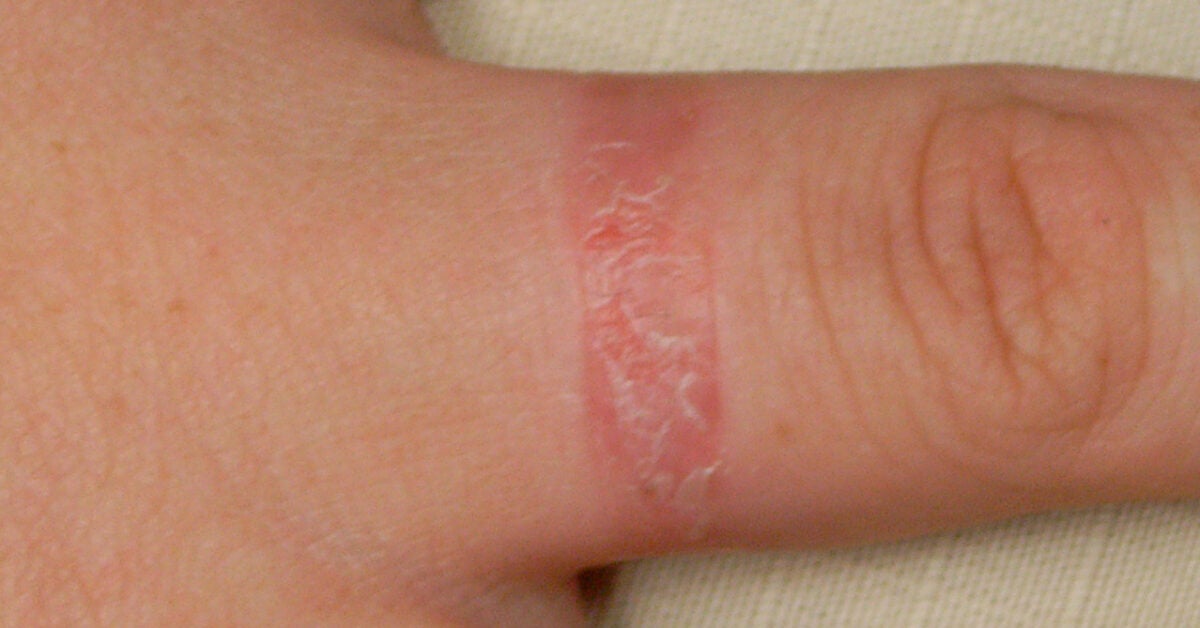Ring rash: Causes, symptoms, and treatment - Medical News Today

If a red, itchy rash develops under a person's wedding ring or another ring they wear continuously, it may be ring rash. The condition is often due to dermatitis. While home remedies may be effective, sometimes the rash needs medical attention.
Ring rash generally develops under the ring's metal band and is most noticeable when a person removes the ring. A person may suddenly develop a rash after years of wearing jewelry with no issues. These rashes may also appear and disappear or become a chronic skin problem.
In this article, we explore the symptoms and causes of ring rash. We also discuss treatments and when people should seek medical attention.
Generally, ring rash is not commonly associated with new rings but with ones that a person has worn for several years. In addition, the symptoms of this condition can vary between individuals, ranging from mild to severe, and are generally related to the underlying cause of the rash.
Symptoms can include:
- red, scaly, or itchy patches
- discoloration
- swelling
- burning sensation
- dry skin that may crack and bleed
There may be several causes of ring rash, including certain forms of dermatitis and allergic reactions to some metals.
Contact dermatitis
A person may develop ring rash because of contact dermatitis, which occurs when an irritant comes into contact with the skin. If the ring contains nickel, silver, or gold, and individuals have an allergy to these metals, the reaction could trigger ring rash. Between 10–15% of people have some form of contact allergy to metals.
Gold jewelry can also have trace amounts of other metals, which could trigger ring rash. Some of these substances may only come into contact with the skin after years of wear, as sweat and friction erode the ring's outer metal, exposing the underlying layers.
Gold allergies are more common than previously reported. In a 2001 study, researchers studied 4,101 people, of which 9.5% tested positive for this allergy type. Participants with this condition typically showed symptoms on:
- eyelids (7.5%)
- face (19.3%)
- the hands (29.6%)
Irritant contact dermatitis
Irritant contact dermatitis may also trigger ring rash. This form of dermatitis can result from debris in soap, lotions, dirt, and moisture staying on the skin under the ring, creating a barrier between a person's skin and air. This debris may attract bacteria, leading to skin irritation and ring rash.
There are several home treatments for ring rash. However, a person may need more than one treatment to clear the rash.
Clear nail polish
If a person thinks an allergic reaction to the metal in their ring is triggering ring rash, clear nail polish may help.
Apply one or several layers of clear nail varnish to the inside of the ring band. This forms a barrier between the metal allergen and the skin, preventing further allergic reactions.
Professional jewelry cleaning
Rings can accumulate debris from dirt, skin, and creams. Professional cleaning should remove this debris while leaving the jewelry undamaged.
After cleaning, the ring rash may resolve when a person puts on the ring, if debris, and the resulting bacteria, was the cause of the rash.
Moisturize
Keeping the skin moisturized may help control ring rash. It is a good idea to remove rings before washing the hands to allow the skin to dry. A person can apply moisturizer after the skin has dried.
In addition, keeping the skin moisturized may help with contact dermatitis, as the condition can be related to eczema, which benefits from hydrated skin. Ointments, such as petroleum jelly for dermatitis, have a high oil content to help lock in moisture.
Use gentle soaps
Repetitive hand washing can strip proteins from the top layer of the skin, damaging its protective barrier.
This increases the risk of skin infections and may trigger irritant hand dermatitis, leading to dry, itchy, flaky skin, particularly between the fingers.
If someone has ring rash or another skin condition, they may be at greater risk of skin damage.
Some soaps and other cleansers can also be particularly harsh on the skin, causing it to dry out. Gentle soaps generally have a low pH level and can be gentler on the skin.
People can also protect their hands with latex or rubber gloves before using dish soap, other cleaning products, or shampooing hair.
Many people find they can successfully treat ring rash at home. However, they may wish to contact their doctor if they have tried several treatments and the rash:
- persists
- spreads
- becomes more severe
A healthcare professional can prescribe stronger medications, including topical steroid cream, or medications to treat the inflammation and allergic reaction.
If a person develops an infection from ring rash, they may need treatment with oral or topical antibiotics.
It is essential to contact a doctor if people experience blisters with a ring rash. These blisters or sores could indicate a more serious condition, such as eczema herpeticum, which is due to the herpes simplex virus. Although it is more common in children and people with severe eczema, the condition can occur in anyone who has dermatitis.
Ring rash is a common skin condition that typically requires minimal at-home treatments. However, it is important to find the underlying cause, which could be an allergic reaction to metals or another form of dermatitis.
A person may need medical attention if the ring rash does not go away or becomes worse.
Seek immediate medical advice if the ring rash develops blisters, as it may signify a more severe infection.

Comments
Post a Comment